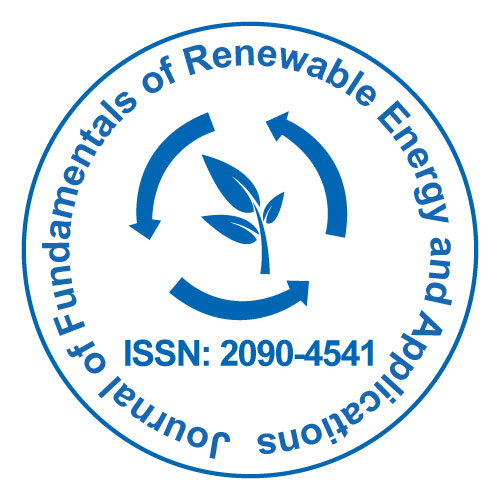
Journal of Fundamentals of Renewable Energy and Applications
Open Access
ISSN: 2090-4541

ISSN: 2090-4541
Perspective - (2024)Volume 14, Issue 4
In the face of growing concerns about climate change and the transition to a low-carbon economy, renewable energy has become a key part of the global energy mix. Technologies like solar and wind power are essential to reducing greenhouse gas emissions, but their intermittent nature presents significant challenges for grid stability and energy management. This is where advanced Lithium-ion (Li-ion) storage systems come into play. Lithium-ion batteries are emerging as the leading technology for storing renewable energy, offering a way to bridge the gap between renewable energy production and consumption. Solar power depends on sunlight, and wind power depends on wind speeds, both of which fluctuate throughout the day and across seasons. This intermittency makes it difficult to rely on renewable sources for continuous power supply without backup systems or storage solutions.
Energy storage technologies allow renewable energy to be stored during periods of high generation and released during periods of low generation or high demand. These systems are key to overcoming the temporal mismatch between energy production and consumption, ensuring a stable and reliable energy supply. Advanced lithium-ion batteries have emerged as one of the most promising technologies for storing and managing renewable energy due to their high energy density, efficiency, and relatively long lifespan.
Lithium-ion batteries have been widely used in consumer electronics, Electric Vehicles (EVs), and grid energy storage for over a decade. In the context of renewable energy management, the main areas of improvement for lithium-ion batteries have been energy density, cycle life, charging speeds, and safety. Higher energy density allows lithium-ion batteries to store more energy in a compact space, which is crucial for large-scale energy storage applications. This improvement in energy density helps make renewable energy storage more efficient, reducing the need for large-scale storage facilities and lowering costs. Advanced lithium-ion batteries have seen improvements in cycle life, with some systems capable of performing tens of thousands of cycles before significant degradation occurs. Longer cycle life is particularly important for renewable energy storage, as it reduces the need for frequent replacement and lowers the overall cost of storage systems over time. Faster charging times are another key area of improvement. Advanced lithium-ion batteries now offer much faster charging capabilities than their predecessors. This is particularly useful for managing short-term fluctuations in renewable energy generation, where energy can be quickly stored during periods of surplus generation and rapidly discharged during periods of high demand or low generation. Advances in battery chemistry and design have led to significant improvements in the thermal stability and safety of lithium-ion batteries. Modern Battery Management Systems (BMS) monitor battery health and performance, preventing overcharging, overheating, and short circuits, which are potential risks associated with energy storage.
The integration of lithium-ion storage with renewable energy systems is vital for enabling a reliable and stable power grid. Storage systems allow energy to be stored when renewable power generation is abundant and released when needed. This enhances the ability of renewable energy to meet demand at all times, even during periods of low generation. The use of lithium-ion batteries in this context is especially important because of their ability to quickly respond to fluctuations in energy supply and demand. The use of advanced lithium-ion batteries for renewable energy storage offers several key advantages over other energy storage technologies, such as leadacid batteries, pumped hydro storage, and compressed air energy storage. Lithium-ion batteries have an energy efficiency of around 90%-95%, meaning that a large portion of the energy put into the battery during charging is retrievable during discharge. This is significantly higher than traditional energy storage technologies, such as lead-acid batteries, which typically have an efficiency of around 70%-80%. The high efficiency of lithiumion batteries helps to maximize the effectiveness of renewable energy storage systems. Lithium-ion batteries can respond almost instantaneously to changes in energy supply and demand, making them ideal for applications that require quick adjustments, such as frequency regulation and grid stabilization. While the production of lithium-ion batteries involves some environmental impact, it is far less than the environmental costs associated with fossil fuels or other energy storage technologies.
Advanced lithium-ion storage technology plays an essential role in enhancing renewable energy management by providing a reliable and efficient way to store and discharge renewable energy. With advancements in energy density, cycle life, charging speed, and safety, lithium-ion batteries are well-positioned to support the growing demand for renewable energy and help facilitate the transition to a sustainable, low-carbon energy future. While challenges remain, ongoing research and innovation in battery technology are likely to further improve the performance, affordability, and environmental sustainability of lithium-ion batteries, making them an integral part of a cleaner and more resilient energy system.
Citation: Trinopy S (2024). Advanced Lithium-Ion Storage for Enhanced Renewable Energy Management. J Fundam Renewable Energy Appl. 14:366.
Received: 27-Nov-2024, Manuscript No. JFRA-24-36236; Editor assigned: 29-Nov-2024, Pre QC No. JFRA-24-36236 (PQ); Reviewed: 13-Dec-2024, QC No. JFRA-24-36236; Revised: 20-Dec-2024, Manuscript No. JFRA-24-36236 (R); Published: 27-Dec-2024 , DOI: 10.35248/2090-4541.24.14.366
Copyright: © 2024 Trinopy S. This is an open-access article distributed under the terms of the Creative Commons Attribution License, which permits unrestricted use, distribution and reproduction in any medium, provided the original author and source are credited.